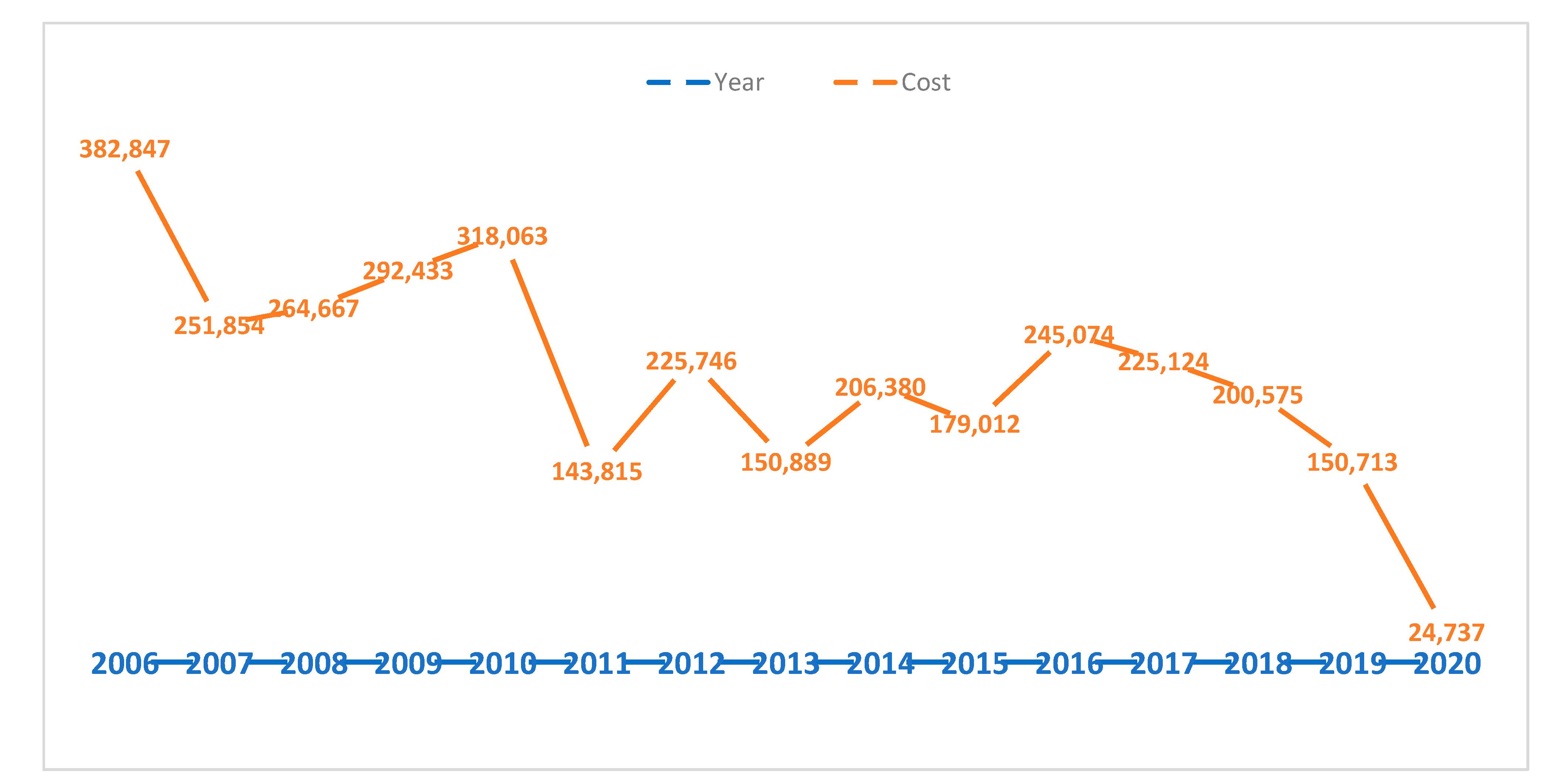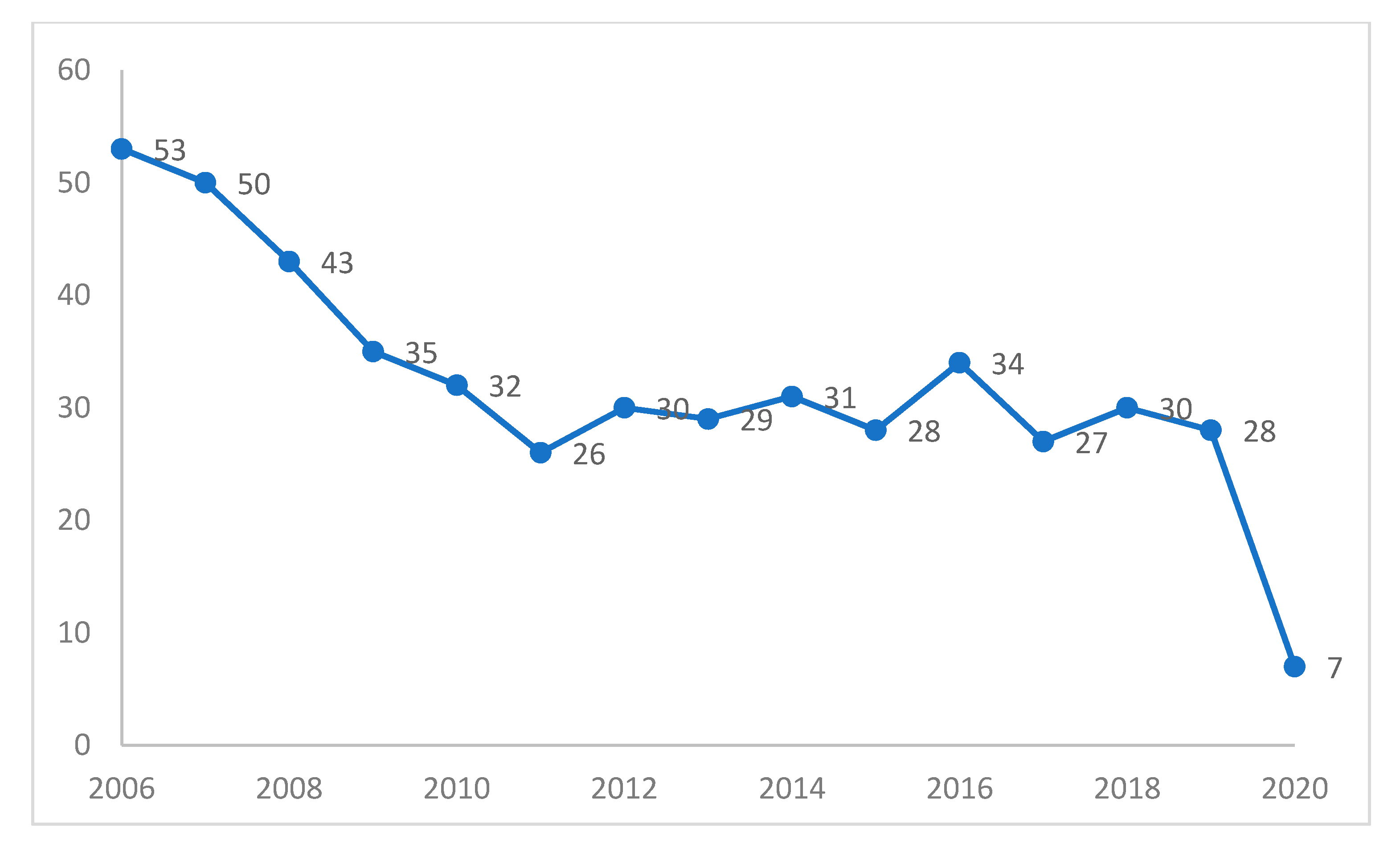Pediatric Hospitalization for Varicella in an Italian Pediatric Hospital: How Much Does It Cost?
Abstract
:1. Background
2. Material and Methods
2.1. Study Design
2.2. Data Sources
3. Results
4. Discussion
5. Conclusions
Authors Contribution
Funding
Institutional Review Board Statement
Informed Consent Statement
Data Availability Statement
Conflicts of Interest
Abbreviations
References
- De Boer, P.T.; Wilschut, J.C.; Postma, M.J. Cost-effettiveness of vaccination against herpes zoster. Hum. Vaccin. Immunother. 2014, 10, 2048–2061. [Google Scholar] [CrossRef] [PubMed] [Green Version]
- Freer, G.; Pistello, M. Varicella-zoster virus infection: Natural history, clinical manifestations, immunity and current and future vaccination strategies. New Microbiol. 2018, 41, 95–105. [Google Scholar] [PubMed]
- Bozzola, E.; Bozzola, M. Varicella complications and universal immunization. J. Pediatr. 2016, 92, 328–330. [Google Scholar] [CrossRef] [PubMed] [Green Version]
- Bernal, J.L.; Hobbelen, P.; Amirthalingam, G. Burden of varicella complications in secondary care, England, 2004 to 2017. Eur. Surveill. 2019, 24, 1900233. [Google Scholar] [CrossRef] [PubMed] [Green Version]
- Bozzola, E.; Quondamcarlo, A.; Krzysztofiak, A.; Pandolfi, E.; Lancella, L.; Tozzi, A. Haematological Complications in otherwise healthy children hospitalized for varicella. Vaccine 2011, 29, 1534–1537. [Google Scholar]
- Bozzola, E.; Spina, G.; Russo, R.; Bozzola, M.; Corsello, G.; Villani, A. Anxiety disorders in acute central nervous system infections. Ital. J. Pediatrics 2020, 46, 23. [Google Scholar] [CrossRef] [PubMed] [Green Version]
- European Centre for Disease Prevention and Control. Public Health Guidance on Varicella Vaccination in the European Union. Available online: https://www.ecdc.europa.eu/en/publications-data/public-health-guidance-varicella-vaccination-european-union (accessed on 1 August 2021).
- Epicentro. Vaccinazioni in Infanzia e Adolescenza: I Dati Nazionali 2019. Available online: https://www.epicentro.iss.it/vaccini/coperture-infanzia-adolescenza-2019 (accessed on 1 August 2021).
- European Centre for Disease Prevention and Control. Vaccine Schedules in All Countries in the EU/EEA. Available online: https://vaccine-schedule.ecdc.europa.eu/Scheduler/ByDisease?SelectedDiseaseId=11&SelectedCountryIdByDisease=-1 (accessed on 1 August 2021).
- Bozzola, E.; Spina, G.; Russo RBozzola, M.; Corsello, G.; Villani, A. Mandatory vaccinations in European countries, undocumented information, false news and the impact on vaccination uptake: The position of the Italian pediatric society. Ital. J. Pediatr. 2018, 44, 67. [Google Scholar] [CrossRef] [PubMed]
- Ministero della Salute. Piano Nazionale Prevenzione Vaccinale 2017–2019. Available online: http://www.salute.gov.it/imgs/C_17_pubblicazioni_2571 (accessed on 1 August 2021).
- Ministero della Salute. Direzione Generale della Prevenzione Sanitaria. Ufficio 5—Prevenzione delle Malattie Trasmissibili e Profilassi Internazionale. Available online: https://www.salute.gov.it/portale/vaccinazioni/homeVaccinazioni.jsp (accessed on 1 August 2021).
- Hobbelena, P.H.F.; Stowea, J.; Amirthalingama, G.; Millera, L.; van Hoek, A.J. The burden of hospitalisation for varicella and herpes zoster in England from 2004 to 2013. J. Infect. 2016, 73, 241–253. [Google Scholar] [CrossRef] [PubMed] [Green Version]
- Wysocki, J.; Malecka, I.; Stryczynska-Kazubska, J.; Rampakakis, E.; Kuter, B.; Wolfson, L.J. Varicella in Poland: Economic burden in children 1–12 years of age in Poland, 2010–2015. BMC Public Health 2018, 18, 410. [Google Scholar] [CrossRef] [PubMed] [Green Version]
- Meszner, Z.; Molnar, Z.; Rampakakis, E.; Yang, H.K.; Kuter, B.J.; Wolfson, L.J. Economic burden of varicella in children 1–12 Years of age in Hungary, 2011–2015. BMC Infect. Dis. 2017, 17, 495. [Google Scholar] [CrossRef] [Green Version]
- Azzari, C.; Baldo, V.; Giuffrida, S.; Gani, R.; O’Brien, E.; Alimenti, C.; Daniels, V.J.; Wolfson, L.J. The Cost-Effectiveness of Universal Varicella Vaccination in Italy: A Model-Based Assessment of Vaccination Strategies. Clin. Outcomes Res. 2020, 12, 273–283. [Google Scholar] [CrossRef]
- Marin, M.; Marti, M.; Kambhampati, A.; Jeram, S.M.; Seward, J.F. Global Varicella Vaccine Effectiveness: A Meta-analysis. Pediatrics 2016, 137, e20153741. [Google Scholar] [CrossRef] [Green Version]
- Kauffmann, F.; Bechini, A.; Bonanni, P.; Casabona, G.; Wutzler, P. Varicella Vaccination in Italy and Germany—Different Routes to Success: A Systematic Review. Expert Rev. Vaccines 2020, 19, 843–869. [Google Scholar] [CrossRef]
- Ghirardo, S.; Ullmann, N.; Ciofi Degli Atti, M.L.; Raponi, M.; Cutrera, R. Delayed season’s onset and reduction of incidence of bronchiolitis during COVID-19 pandemic. Pediatr. Pulmonol. 2021, 56, 2780–2781. [Google Scholar] [CrossRef] [PubMed]
- Lee, H.H.; Lin, S.H. Effects of Covid19 prevention measures on other common infections, Taiwain. Emerg. Infect. Dis. 2020, 26, 2509–2511. [Google Scholar] [CrossRef] [PubMed]
- Itaya, T.; Furuse, Y.; Jindai, K. Does COVID-19 infection impact on the trend of seasonal influenza infection? 11 countries and regions, from 2014 to 2020. Int. J. Infect. Dis. 2020, 97, 78–80. [Google Scholar] [CrossRef] [PubMed]
- Russo, R.; Bozzola, E.; Palma, P.; Corsello, G.; Villani, A. Pediatric routine vaccinations in the COVID 19 lockdown period: The survey of the Italian Pediatric Society. Ital. J. Pediatrics 2021, 47, 72. [Google Scholar] [CrossRef] [PubMed]


| Complication | Mean Cost | Range Cost |
|---|---|---|
| Hematological | EUR 4759.50 | from EUR 1130.74 to EUR 37,700.90 |
| Neurological | EUR 4535.70 | from EUR 198.76 to EUR 11,796.79 |
| Cutaneous | EUR 4292.50 | from EUR 597.76 to EUR 18,997.38 |
| Gastrointestinal | EUR 4711.80 | from EUR 605.34 to EUR 33,525.04 |
| Pulmonary | EUR 5043.50 | from EUR 1130.74 to EUR 37,700.90 |
| Osteoarticular | EUR 7585.73 | from EUR 1693.28 to EUR 31,691.27 |
| Urinary | EUR 7730.58 | from EUR 817.29 to EUR 31,691.27 |
| Cardiac | EUR 17,813.49 | from EUR 7336.86 to EUR 37,700.90 |
| Uncomplicated | EUR 3382.30 | from EUR 558.44 to EUR 42,608.00 |
Publisher’s Note: MDPI stays neutral with regard to jurisdictional claims in published maps and institutional affiliations. |
© 2021 by the authors. Licensee MDPI, Basel, Switzerland. This article is an open access article distributed under the terms and conditions of the Creative Commons Attribution (CC BY) license (https://creativecommons.org/licenses/by/4.0/).
Share and Cite
Bozzola, E.; Spina, G.; Marchili, M.R.; Brusco, C.; Guolo, S.; Rossetti, C.; Logrieco, G.; Pignatelli, F.; Raponi, M.; Villani, A. Pediatric Hospitalization for Varicella in an Italian Pediatric Hospital: How Much Does It Cost? Int. J. Environ. Res. Public Health 2021, 18, 12053. https://0-doi-org.brum.beds.ac.uk/10.3390/ijerph182212053
Bozzola E, Spina G, Marchili MR, Brusco C, Guolo S, Rossetti C, Logrieco G, Pignatelli F, Raponi M, Villani A. Pediatric Hospitalization for Varicella in an Italian Pediatric Hospital: How Much Does It Cost? International Journal of Environmental Research and Public Health. 2021; 18(22):12053. https://0-doi-org.brum.beds.ac.uk/10.3390/ijerph182212053
Chicago/Turabian StyleBozzola, Elena, Giulia Spina, Maria Rosaria Marchili, Carla Brusco, Stefano Guolo, Chiara Rossetti, Giuseppe Logrieco, Francesca Pignatelli, Massimiliano Raponi, and Alberto Villani. 2021. "Pediatric Hospitalization for Varicella in an Italian Pediatric Hospital: How Much Does It Cost?" International Journal of Environmental Research and Public Health 18, no. 22: 12053. https://0-doi-org.brum.beds.ac.uk/10.3390/ijerph182212053






